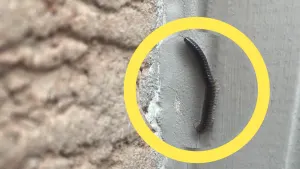
Watch for an extremely rare 'nearly total' lunar eclipse this fall
This November event will feature the longest partial lunar eclipse in more than 580 years!
Combining comfortable weather with longer nights, Fall is an excellent time of the year to stargaze and observe the numerous meteor showers that take place during the season.
In addition to the astronomical events we typically see during the Fall, there's an exceptional event in the coming season that will be visible in the sky across Canada. On November 19, the Full Moon will pass through Earth's shadow, resulting in a rare lunar eclipse, the likes of which have not been seen in over 500 years!
Here is our guide to the astronomical sights on display for Fall 2021.
Sep 22: Fall Equinox (northern hemisphere)
Oct 4: Zodiacal Light in the east before dawn for 2 weeks
Oct 9: Waxing Crescent Moon near Venus
Oct 14-15: Waxing Gibbous Moon passes by Saturn and Jupiter
Oct 20: Full Hunter's Moon
Oct 20-21: Orionid Meteor Shower peak
Nov 3: Waning Crescent Moon passes in front of Mercury
Nov 4-5: Southern Taurid meteor shower peaks
Nov 8: Waxing Crescent Moon near Venus
Nov 10-11: First Quarter Moon passes by Saturn and Jupiter
Nov 11-12: Northern Taurid meteor shower peak
Nov 17: Leonid meteor shower peak
Nov 18-19: Full Beaver Moon and rare Partial Lunar Eclipse
Dec 3: Waning Crescent Moon near Mars and very bright Venus
Dec 4: Total Solar Eclipse across Antarctica
Dec 7: Waxing Crescent Moon near Venus
Dec 8-9: Waxing Crescent Moon passes by Saturn and Jupiter
Dec 13-14: Geminid meteor shower peak
Dec 19: Full Cold Moon
Dec 21: Winter Solstice (northern hemisphere)
Visit our Complete Guide to Fall 2021 for an in-depth look at the Fall Forecast, tips to plan for it and much more!
THE ZODIACAL LIGHT
Would you like to catch a glimpse of an immense interplanetary dust cloud that surrounds the Sun? In early fall, sharp-eyed skywatchers will have a chance to spot an elusive phenomenon known as the Zodiacal Light.
On clear nights and under dark skies, look to the eastern horizon, in the half an hour just before morning twilight begins, between the dates of October 4-18. Specifically, you are watching for a diffuse white glow shaped in the form of a pyramid. The base will be along the horizon, and the peak will extent high into the sky, angled towards the south.
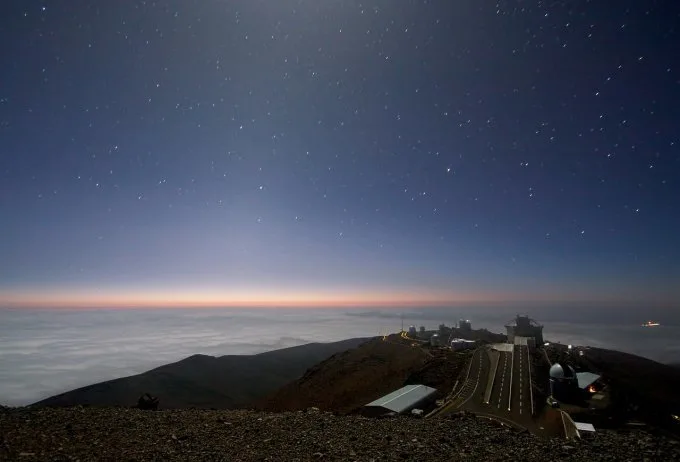
Moonlight and zodiacal light over La Silla. Credit: European Southern Observatory (ESO)
In the Royal Astronomical Society of Canada's 2021 Observer's Handbook, Dr. Roy Bishop, Emeritus Professor of Physics from Acadia University, wrote: "The zodiacal light appears as a huge, softly radiant pyramid of white light with its base near the horizon, and its axis centred on the zodiac (or better, the ecliptic). In its brightest parts, it exceeds the luminance of the central Milky Way."
As mentioned above, the zodiacal light is produced by sunlight glinting off grains of dust that orbit the Sun in an immense disk. We can only see this at specific times of the year, however. In February and March, it is typically seen in the western sky, in the half-hour after evening twilight has ended, in the two weeks just after the Full Moon. In September and October, we can see it in the eastern sky, in the half-hour or so before morning twilight begins, in the two weeks after the New Moon. This year, it can be seen starting in the first week of October, and it should remain visible until about the middle of the month.
New research has shed fresh light on this phenomenon. It was once thought that the dust cloud that produces the zodiacal light originated from comet tails. However, this year, researchers published a study using data from NASA's Juno spacecraft that revealed it may actually be Martian dust floating in space!
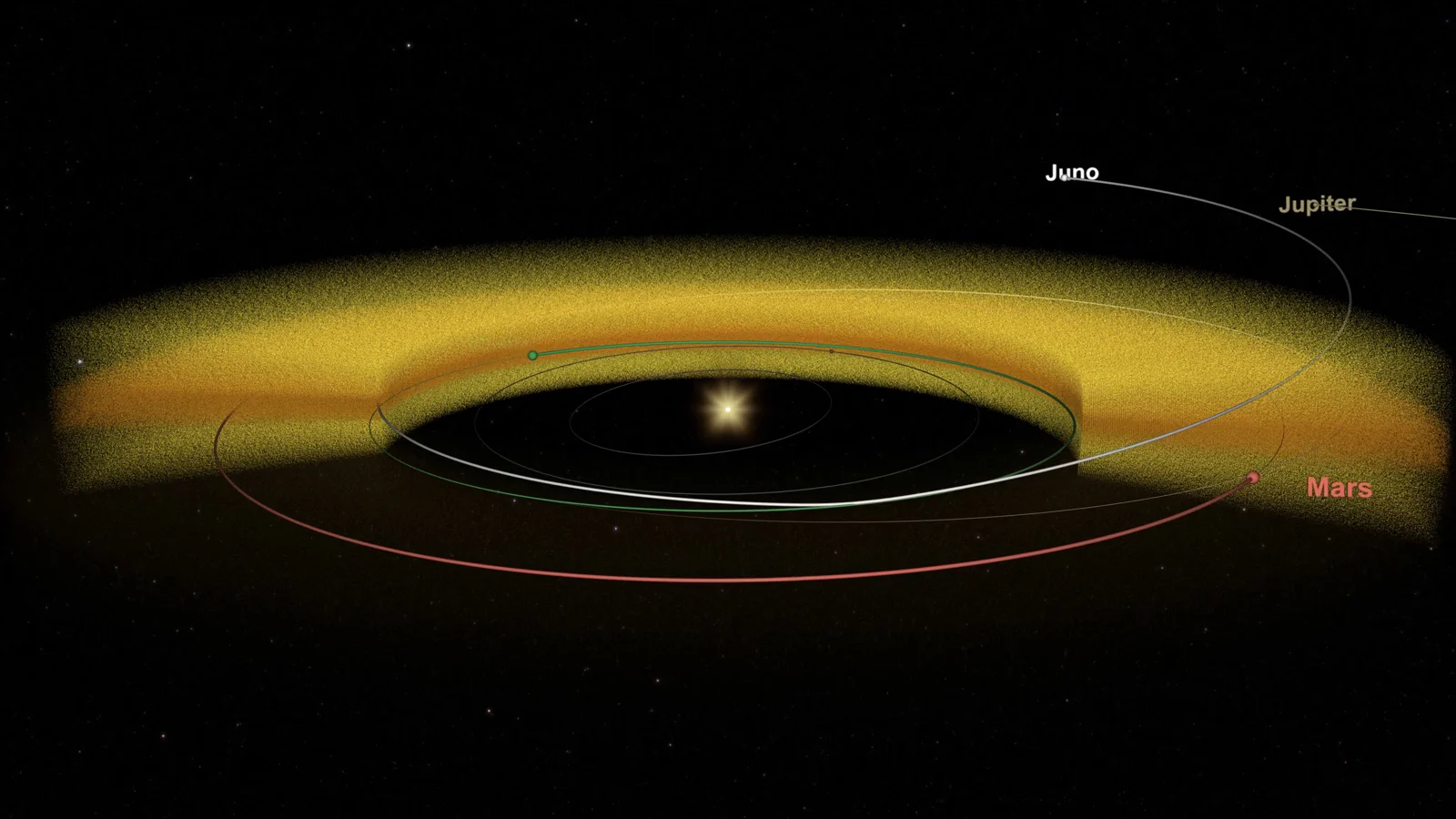
This diagram shows Juno's path (white) around the inner solar system, with Earth's orbit (blue) and Mars' orbit (red). The interplanetary dust cloud extends from Earth's orbit outward to the asteroid belt, with Mars right in the middle. Credit: NASA Goddard
According to Dr. Bishop, the zodiacal light can appear quite bright. However, viewers can still miss it due to urban light pollution. Also, due to inexperience, they can think that they missed it by mistakenly believing they are just seeing the glow of twilight.
The best way to be sure that you really are seeing this phenomenon is a) to look up the exact timing of twilight in your area, so that you know precisely when it begins and ends, and b) get away from city lights so that you are sure light pollution isn't going to spoil the view.
THE MOON AND THE PLANETS
The three Full Moons of the Fall season occur on October 20 (Full Hunter's Moon), November 19 (Full Beaver Moon), and December 19 (Full Cold Moon). Due to the Moon's elliptical orbit around Earth, these will be the three farthest and smallest Full Moons of 2021. The Full Cold Moon is 2021's apogee Full Moon — the most distant and smallest of the entire year.
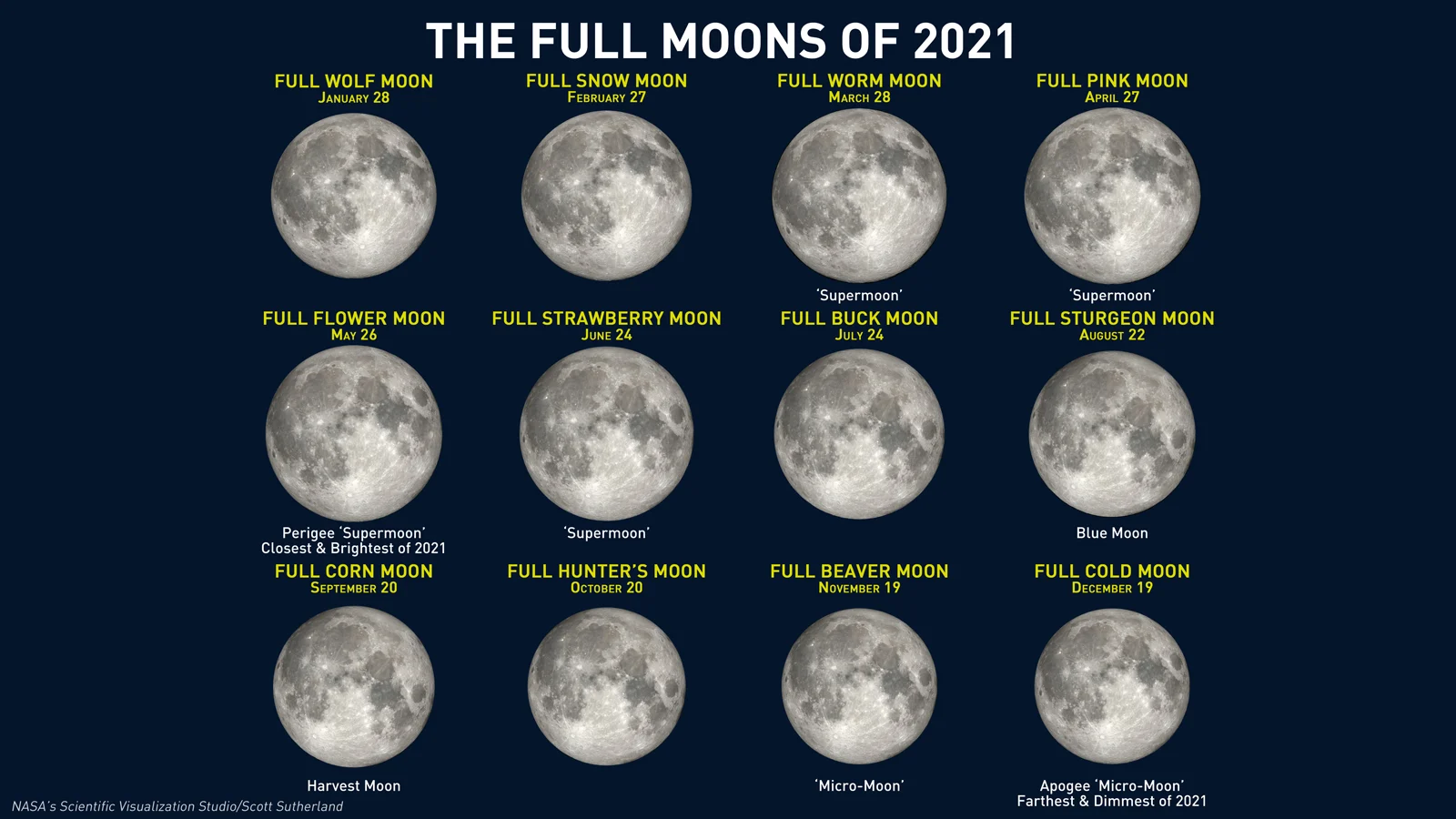
The Full Moon isn't the only object to see in the night sky this season, though.
Look towards the southwestern on any clear evening, and the bright planet Venus should be there, shining near the horizon. On October 9, November 8, and December 7, though, it won't be alone. On each of those nights, a waxing Crescent Moon will appear close by.
Jupiter and Saturn are still up nearly all night long. They appear as a distant pair of bright dots in the sky (although you may have to search a bit for Saturn, depending on how much light pollution there is in your area). The Moon swings by this pair each month. Watch for this from the 14th to the 15th of October, the 10th-11th of November, and the 8th-9th of December.

The Moon hangs in the sky near Jupiter and Saturn, with Venus off to the southwest, on the night of November 10, 2021. Credit: Stellarium
On the morning of November 3, in the hour or so before sunrise, look to the eastern horizon to see the Waning Crescent Moon near the planet Mercury. Later in the day, before the Sun sets, the Moon will even occult Mercury — that is, from our perspective, it will appear as though the Moon passes in front of the planet.
METEOR SHOWERS
Meteor showers occur when Earth passes through streams of icy, dusty debris left behind by comets and certain asteroids. When this happens, the bits of debris in the streams produce streaks of light in our night skies.
Of the four seasons of the year, Fall sees the greatest number of meteor showers. While there are many meteor showers throughout the year, roughly a dozen are best known for being reliable nighttime events. Nearly half of these occur in Fall.
The Draconids meteor shower will be seen between October 6-10, with the peak occurring on the 8th, just two nights after the New Moon. Although this shower only produces about 10 meteors per hour, the favourable Moon phase makes this one of the better ones to see this season.
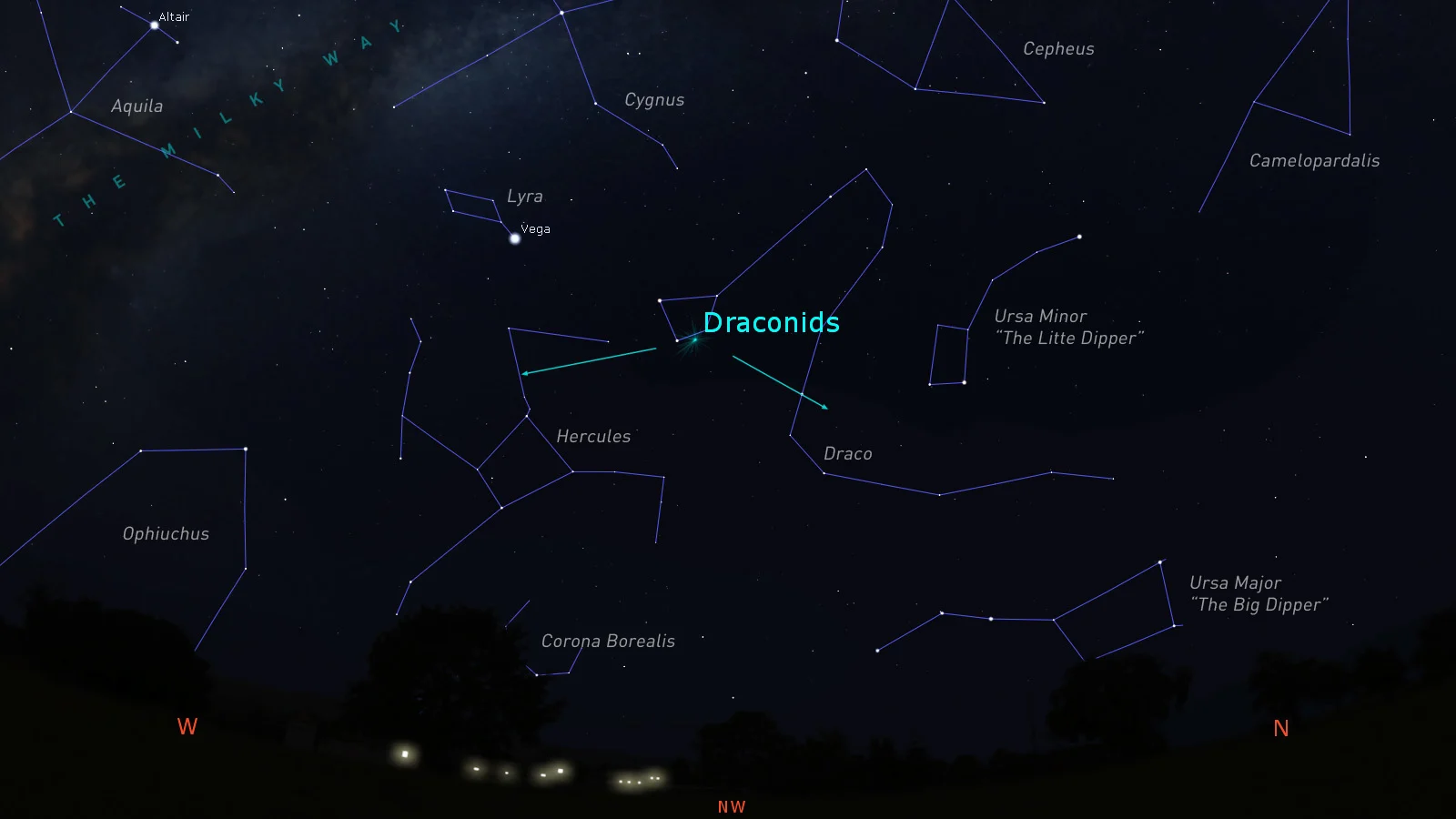
The radiant of the Draconid meteor shower, in the northwestern part of the sky, on the night of October 8, 2021. Credit: Stellarium
The Orionids, the second of two yearly meteor showers that originate from Comet 1P/Halley, run from October 2 to November 7. This produces bright meteors and can deliver up to 20 per hour during their peak on the night of October 20-21. Unfortunately, this meteor shower peaks on the night of the Full Moon, so any dimmer meteors will be lost in the glare of moonlight.

The radiant of the Orionid meteor shower, positioned near the zenith on the night of October 20. Credit: Stellarium
Twin meteor showers — the southern and northern Taurids — overlap in November, not only on the days they occur but also where their meteors appear from in the night sky. The Southern Taurids run from September 10 to November 20 and reach their peak on the night of November 4-5. The Northern Taurids run from October 20 to December 10 and peak on the night of November 11-12. Neither are particularly strong showers, producing maybe 5 meteors per hour at their peaks. However, you can spot Taurid meteors during nearly any night of the entire Fall season.

The twin Taurid meteor showers, on November 4, 2021. Credit: Stellarium
The sources of these two showers, Comet 2P/Encke for the S. Taurids and asteroid 2004 TG10 for the N. Taurids, are thought to be two parts of a larger object that broke apart long ago.
NOTE: There's a handy guide at the bottom of this article for how to get the most out of watching a meteor shower!
The Leonids are another weak meteor shower of the season, producing meteors throughout most of the month of November. During the peak, which takes place on November 17-18, viewers can see up to 10 meteors per hour, similar to the Draconids. However, with the Full Moon only a couple of nights away, this year is not the most ideal to see this meteor shower.
One of the three best meteor showers of the year comes around towards the end of Fall. Geminid meteors, which originate from 'rock comet' asteroid 3200 Phaethon, can be seen anytime from the 4th to the 20th of December. The peak of the shower occurs on the night of the 14th to the 15th.
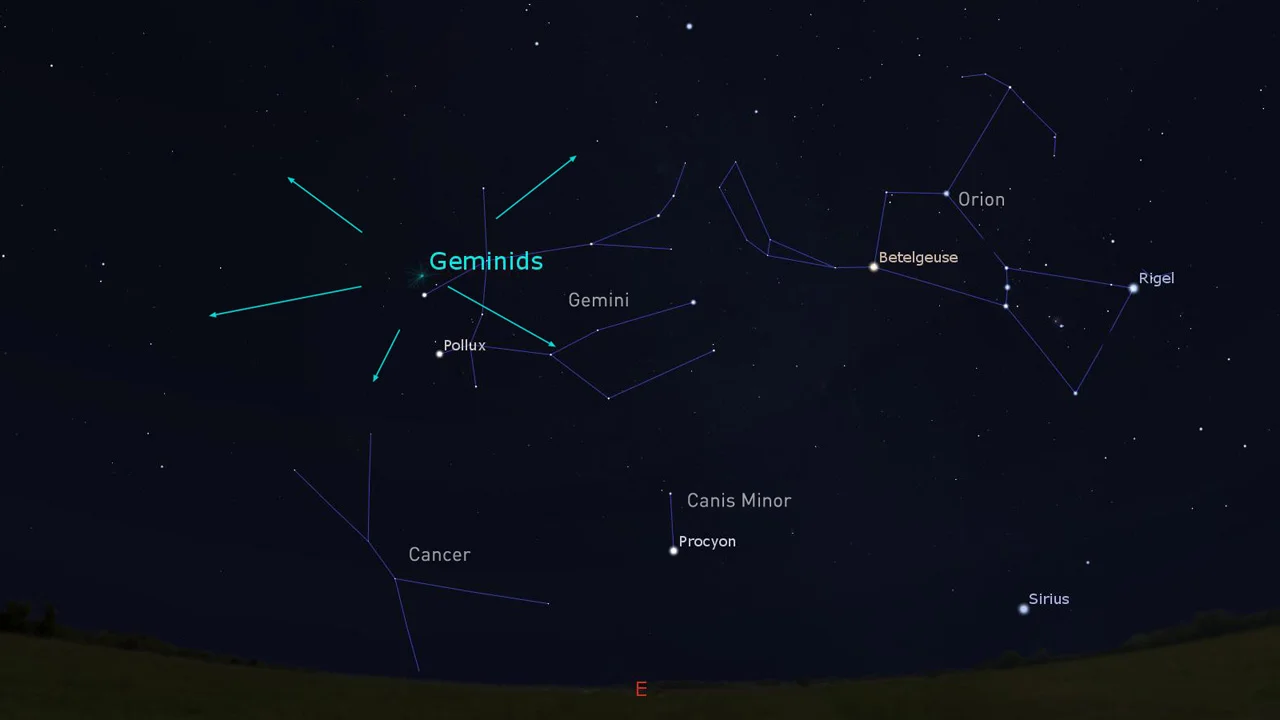
The Geminids radiant, in the east at roughly 10 p.m. on the night of December 14. Credit: Stellarium
While the Waxing Gibbous Moon is not the most favourable for this event, the Geminids can produce up to 100 meteors or more per hour during the peak. Thus, as long as viewers keep the Moon out of their direct line of sight, they can still enjoy this yearly show.
RARE PARTIAL LUNAR ECLIPSE
On the night of November 18-19, the Full Moon will pass through Earth's shadow. This will result in a partial lunar eclipse — where the Moon only partly dips into the dusky red umbra of Earth's shadow.
What's particularly remarkable about this eclipse is that it's one of the rarest. At its peak, which occurs at just after 4 a.m. EDT on the 19th, the Moon will just barely miss out on being a total lunar eclipse. Instead, just over 2 per cent of the Moon — in a thin sliver near the south pole — will remain in the penumbra.
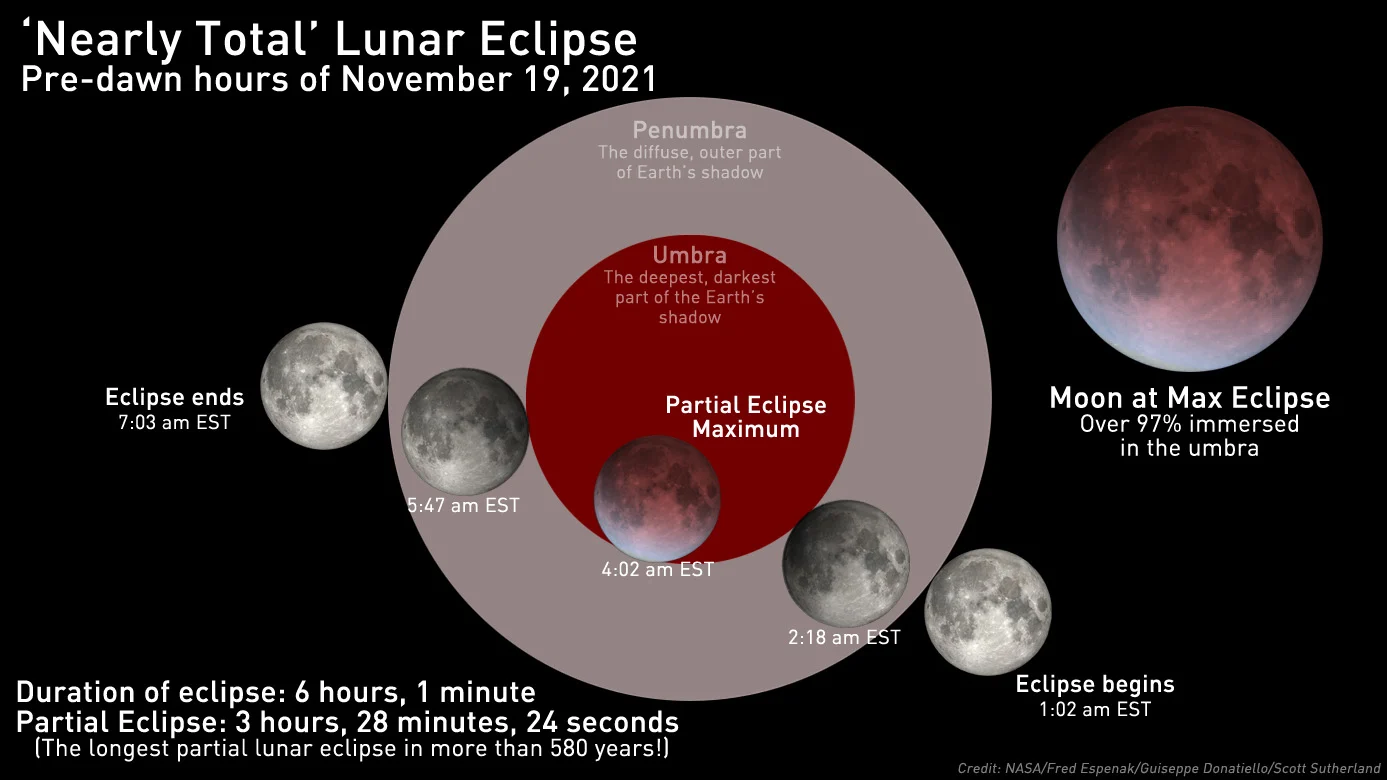
This graphic shows the path of the Full Moon through Earth's shadow in the predawn hours of November 19, 2021. Credit: NASA GSVS/Scott Sutherland
According to NASA's records, the partial phase of this eclipse will last a total of 208.4 minutes, or 3 hours, 28 minutes, and 24 seconds. That makes it one of the longest partial lunar eclipses ever seen!
Before this, the longest 'nearly total' lunar eclipse was over 581 years ago, on February 18, 1440, when there was a partial lunar eclipse that spent 3 hours, 28 minutes, and 48 seconds in the umbra. The next time a longer partial eclipse occurs, where the Moon will spend an even 3 hours and 30 minutes in the umbra without actually producing a total eclipse, will be nearly 648 years from now, on February 8, 2669!
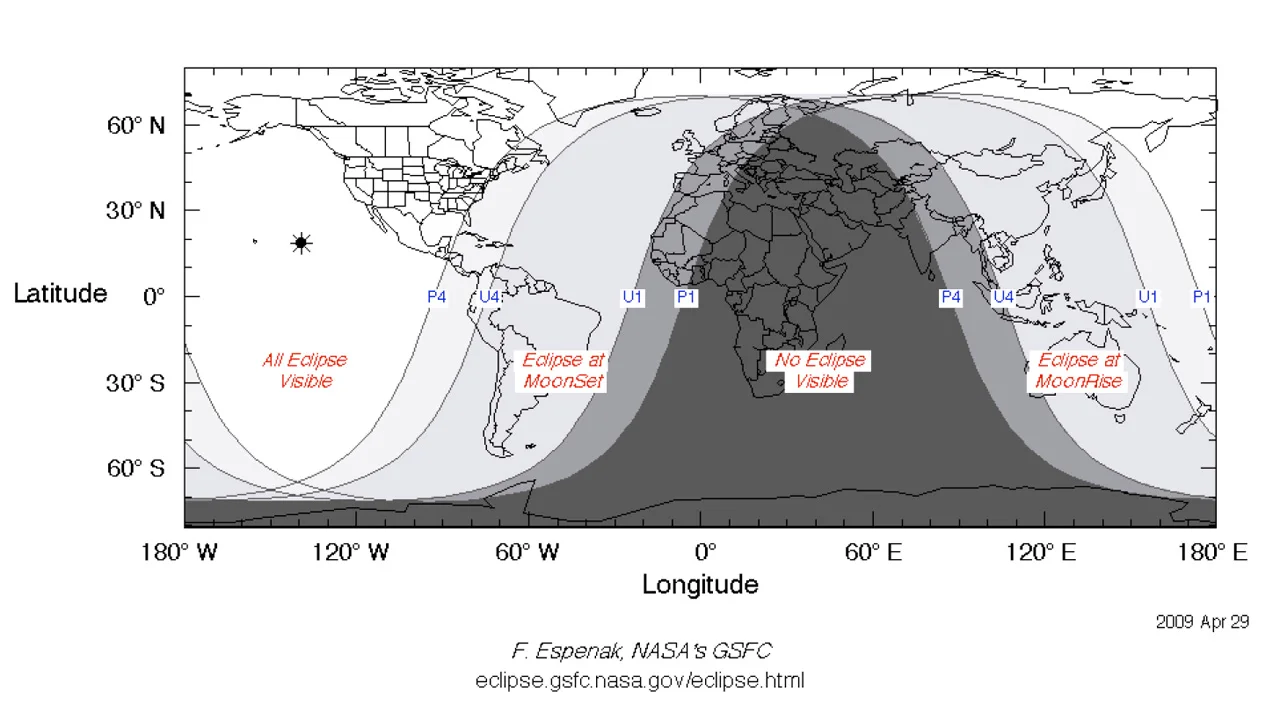
The visibility of the November 19 lunar eclipse includes all of Canada. Only parts of eastern Canada will miss the end of the penumbral eclipse as the Sun rises in the morning. Credit: NASA GSFC/Fred Espenak
This partial eclipse will be visible to all of Canada. The eclipse begins at just after 1 a.m. EST. The best part of the event, when the Moon dips into the umbra, is from 2:18 a.m. to 5:47 a.m., with the eclipse reaching its maximum at 4:02 a.m. EST. Parts of eastern Canada will miss out on the final phase of the eclipse — after the Moon has exited the umbra — as this will occur after sunrise in eastern Quebec and Atlantic Canada (although it's challenging to notice the effects of the penumbra, even under the best conditions).
For viewers in other time zones, don't forget to adjust the above timing to your local time:
NST — Start 2:32 am; Partial 3:48 am - 7:17 am; Max 5:32 am; Ends 8:33 am
AST — Start 2:02 am; Partial 3:18 am - 6:47 am; Max 5:02 am; Ends 8:03 am
EST — Start 1:02 am; Partial 2:18 am - 5:47 am; Max 4:02 am; Ends 7:03 am
CST — Start 12:02 am; Partial 1:18 am - 4:47 am; Max 3:02 am; Ends 6:03 am
MST — Start 11:02 pm; Partial 12:18 am - 3:47 am; Max 2:02 am; Ends 5:03 am
PST — Start 10:02 pm; Partial 11:18 pm - 2:47 am; Max 1:02 am; Ends 4:03 am
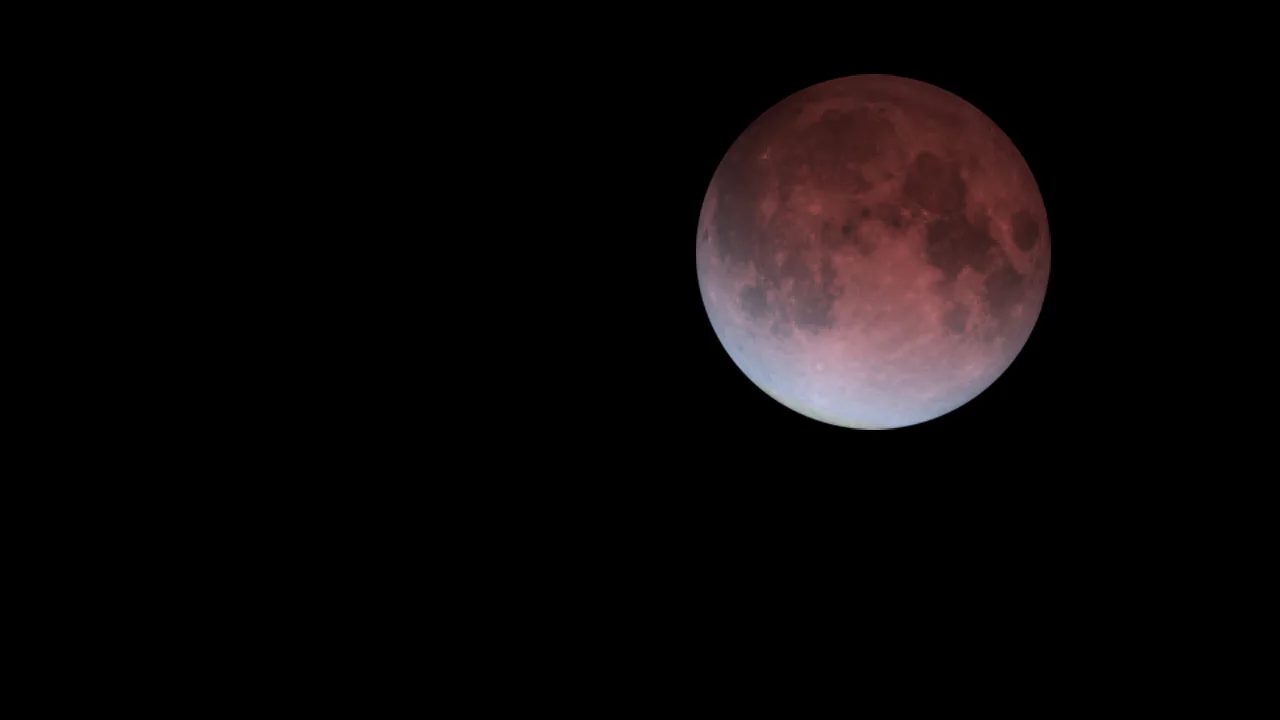
This simulated view of the November 19 partial lunar eclipse shows the "Japanese Lantern Effect" — the variation in colour from north to south over the Moon's surface — that is expected during the peak of the event. Credit: NASA GSVS/Scott Sutherland
TOTAL SOLAR ECLIPSE OVER ANTARCTICA
On the night of December 4th, by Canadian clocks, the Sun, the Moon and Earth will line up just right to produce a total solar eclipse.
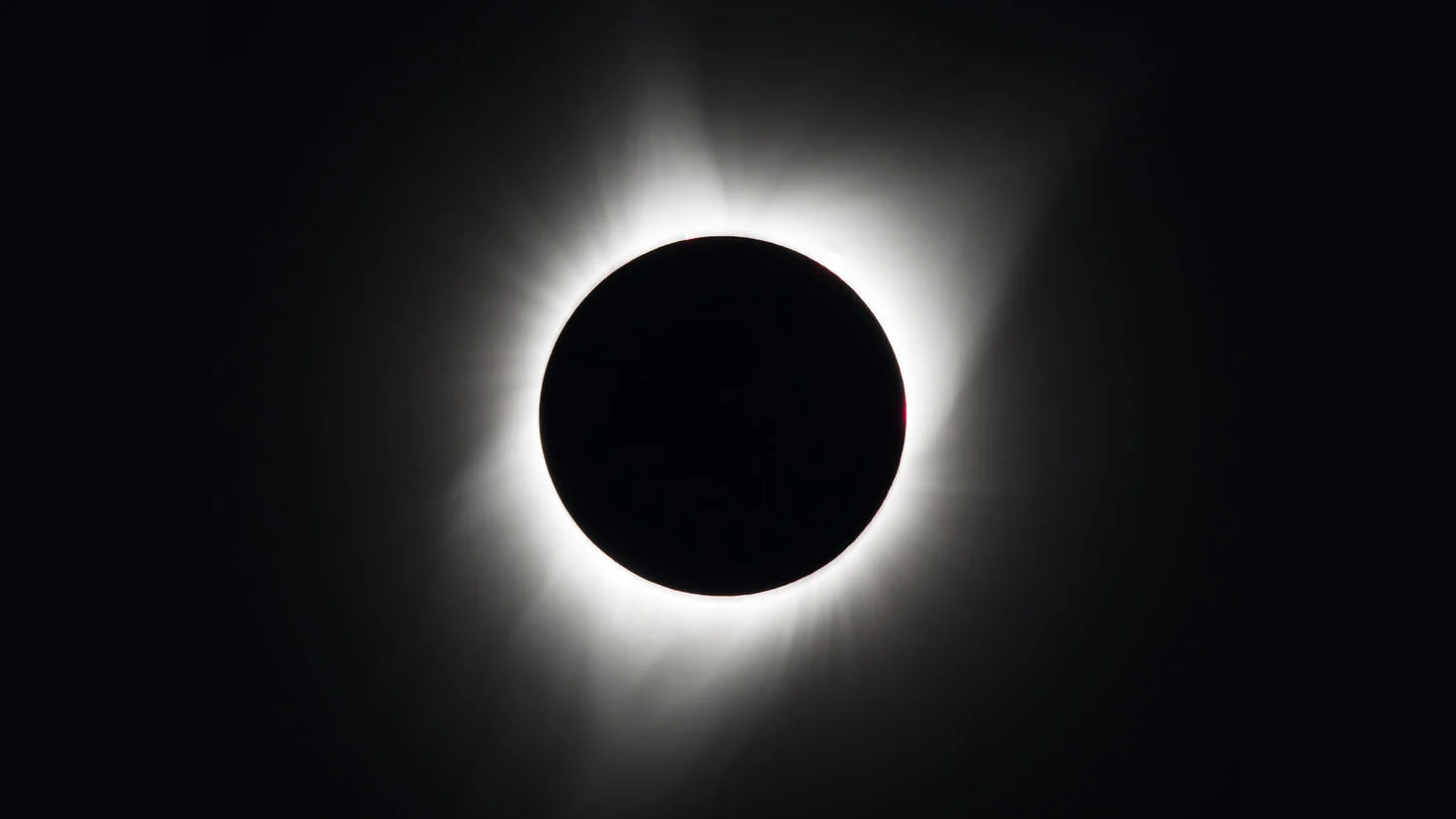
This photograph captures the August 2017 total eclipse of the Sun. Credit: NASA/Aubrey Gemignani
We won't be able to watch it directly from here, however, since the path of the Moon's shadow traces a line that curves across the western half of the continent of Antarctica.
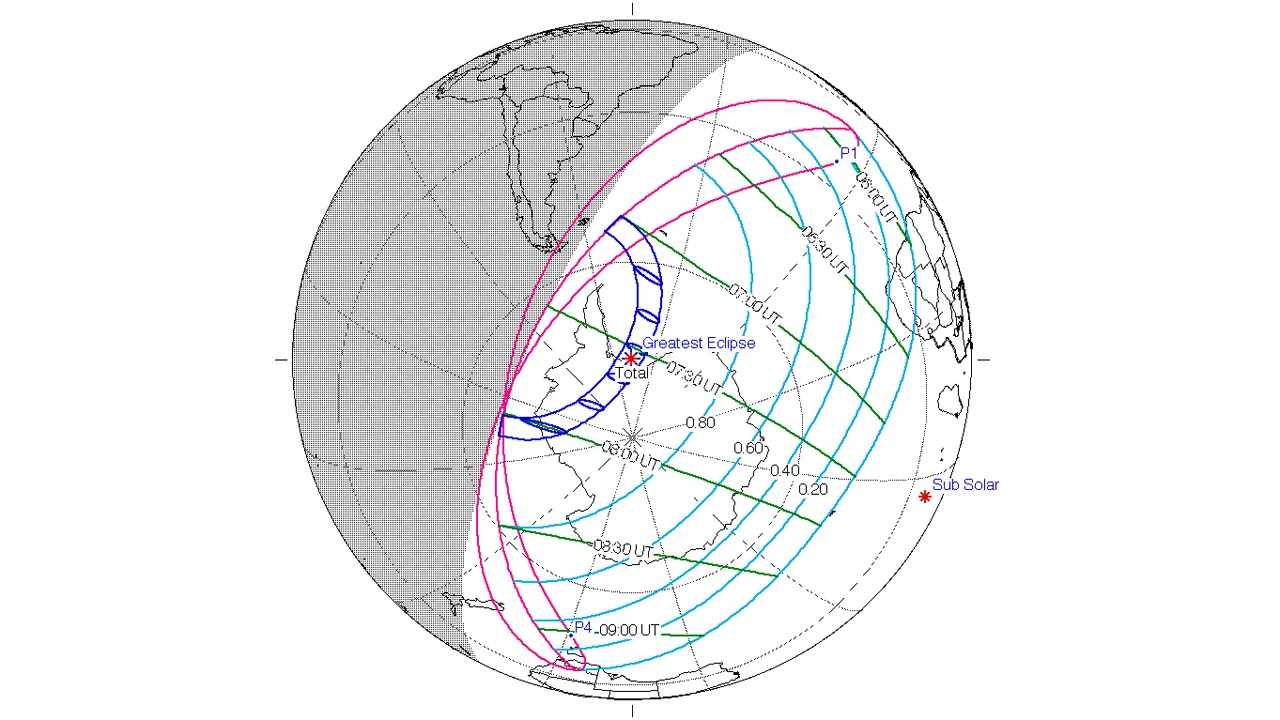
The path of totality of the December 4 solar eclipse traces across some of the most remote locations on Earth. Credit: NASA GSFC/Fred Espenak
As with all solar eclipses, though, someone is bound to be travelling there to see it, and better yet, live stream it so that the rest of us can see it as well.
TIPS FOR STARGAZING AND METEOR SHOWERS
Given how polluted our night skies are with urban light, it is no longer a simple matter to step outside and gaze up at the stars. It's even more difficult to watch an event such as a meteor shower. Follow the tips below, though, and you won't miss out on these amazing events.
There are three 'best practices' for observing the night sky:
Check the weather,
Get away from light pollution, and
Be patient.
Clear skies are very important. Even a few hours of cloudy skies can ruin your chances of watching an event such as a meteor shower. So, be sure to check The Weather Network on TV, on our website, or from our app, and look for my articles on our Space News page, just to be sure that you have the most up-to-date sky forecast.
Next, you need to get away from city light pollution. If you look up into the sky from home, what do you see? The Moon, a planet or two, perhaps a few bright stars such as Vega, Betelgeuse and Procyon, as well as some passing airliners? If so, light pollution in your area is too strong for you to get the most out of something like a meteor shower. You might catch a particularly bright fireball if one happens to fly past overhead, but that's likely all you'll see. So, to get the most out of your stargazing and meteor watching, get out of the city. The farther away you can get, the better.
Watch: What light pollution is doing to city views of the Milky Way
For most regions of Canada, getting out from under light pollution is simply a matter of driving outside of your city, town or village until a multitude of stars is visible above your head.
In some areas, especially in southern Ontario and along the St. Lawrence River, the concentration of light pollution is too high. Getting far enough outside of one city to escape its light pollution tends to put you under the light pollution dome of the next city over. The best options for getting away from light depend on your location. In southwestern Ontario and the Niagara Peninsula, the shores of Lake Erie can offer some excellent views. In the GTA and farther east, drive north and seeking out the various Ontario provincial parks or Quebec provincial parks. Even if you're confined to the parking lot after hours, these are usually excellent locations from which to watch (and you don't run the risk of trespassing on someone's property).
If you can't get away, the suburbs can offer at least a slightly better view of the night sky. Here, the key is to limit the amount of direct light in your field of view. Dark backyards, sheltered from street lights by surrounding houses and trees, are your best haven. The video below provides a good example of what viewing is like based on the concentration of light pollution in the sky. Also, check for dark sky preserves in your area.
When viewing a meteor shower, be mindful of the phase of the Moon. Meteor showers are typically at their best when viewed during the New Moon or when there is a Crescent Moon in the sky. However, the light from a Gibbous or Full Moon can be bright enough to wash out all but the brightest meteors. Since we can't get away from the Moon, the best option is just to time your outing right so the Moon has already set or is low in the sky. Also, you can angle your field of view to keep the Moon out of your direct line of sight. This will reduce its impact on your nightvision and allow you to spot more meteors.
Once you've verified you have clear skies, and you've limited your exposure to light pollution, this is where being patient comes in.
For best viewing, your eyes need some time to adapt to the dark. Give yourself at least 20 minutes, but 30-45 minutes is best, for your eyes to adjust from being exposed to bright light.
Warning: This is possibly the one thing that causes the most disappointment when it comes to watching a meteor shower. Stepping out into the backyard from a brightly lit home and looking up for five minutes, you might be lucky enough to catch a rare bright fireball meteor. However, it's far more likely that you won't see anything at all. However, waiting for at least twenty minutes and avoiding sources of light during that time — streetlights, car headlights and interior lights, and smartphone and tablet screens — greatly improves your chances of avoiding disappointment.
Sometimes, avoiding your smartphone or tablet isn't an option. In this case, set the display to reduce the amount of blue light it gives off, and reduce the screen's brightness. That way it will have less of an impact on your night vision.
You can certainly gaze into the starry sky while you are letting your eyes adjust. You may even see a few of the brighter meteors as your eyes become accustomed to the dark.
Once you're all set, just look straight up and enjoy the view!








